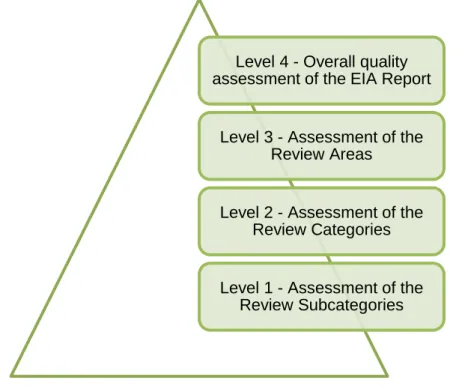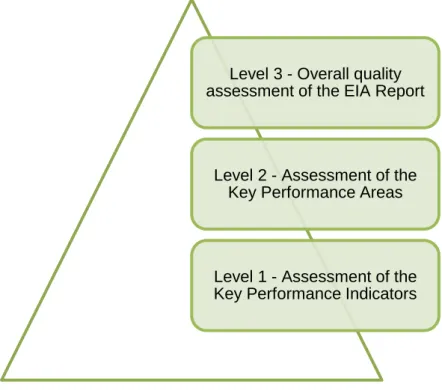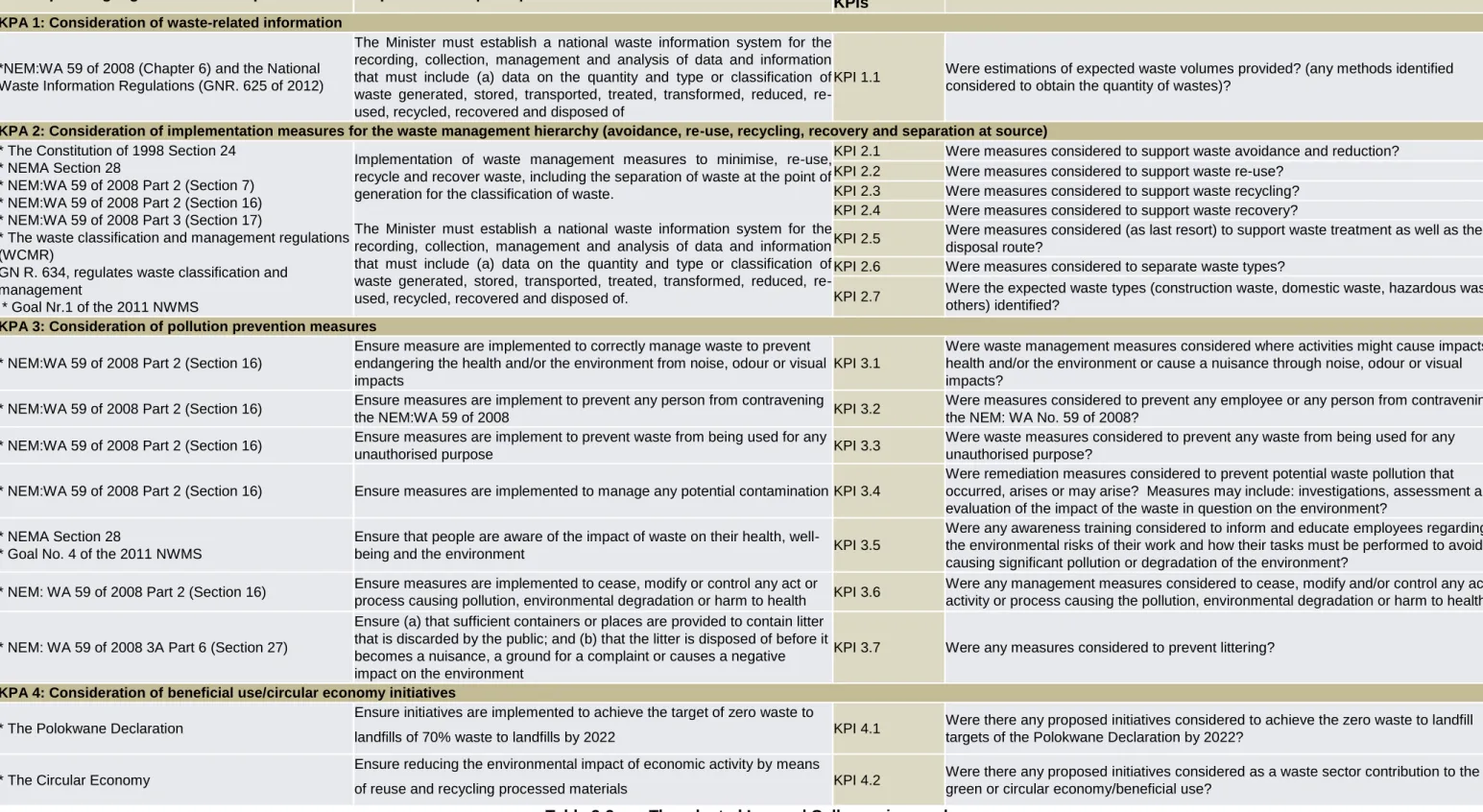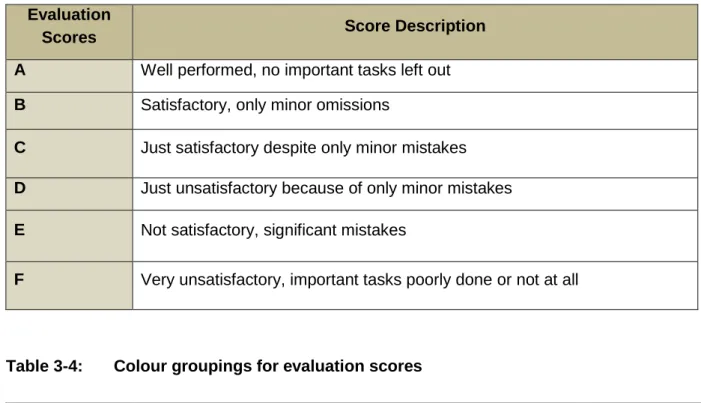This research aimed to review the quality of waste management measures included in environmental impact assessment reports for development in protected areas in South Africa. Waste management measures were generally poorly and inadequately addressed in most cases.
INTRODUCTION
- Background
- Problem statement
- Research aim and question
- Scope of the research
- Contribution of the research
- Structure and outline of the dissertation
- Chapter conclusion
A particular challenge for protected areas is impacts related to tourism-related activities (Whylie et al., 2018). Protected areas (PAs) are one such area where development proposals are often subject to an environmental impact assessment (EIA) (Alberts et al., 2021).
LITERATURE REVIEW
Introduction
Waste Management
- Waste-related Multilateral Environmental Agreements (MEAs) and Sustainable
South Africa's command-and-control, fiscal-based and civil-based approaches, as set out in the 2011 National Waste Management Strategy (Roos, 2020b). In South Africa, the National Waste Management Strategy (NWMS) supports the implementation of the fiscal-based approach that has a financial implication for the polluter.
The current state of waste in South Africa
It is therefore crucial to recognize the importance of the volumes of waste generated in South Africa and the volumes of waste recycled, treated, landfilled and exported (DEA, 2018). In addition, the amount of waste produced will increase due to the lack of aggressive waste avoidance strategies (DEFF, 2020).
The South African legal framework and waste-related legislation
- The Constitution of the Republic of South Africa (1996)
- The National Environmental Management Act (NEMA) No.107 of 1998
- The NEMA EIA Regulations
- The National Environmental Management Waste Act (NEM: WA) No. 59 of 2008
- Waste-related Regulations in terms of NEM: WA No. 59 of 2008
- Waste-related National Norms and Standards in terms of the NEM: WA No. 59 of
- The National Waste Management Strategy
- The Circular Economy
1998, the National Environmental Management Act: Waste 59 of 2008, and the National Waste Management Strategy (NWMS) of 2011 and 2020 which is a legal requirement of the National Environmental Management Waste Act (DEFF, 2020). As a result of the criticality of waste management in South Africa, specific legislation has been developed that deals directly with waste management (Zhakata et al., 2016). The National Waste Management Strategy will be discussed in more detail in section 2.4.4 which focuses mainly on the NWMS.
In general, the National Norms and Standards therefore potentially simplify the implementation of the waste management hierarchy. 344, the National Waste Management Strategy was established and will be discussed in the next section. The National Waste Management Strategy (NWMS) is a legislative requirement of the National Environmental Management: Waste Act (NEM: WA) No.
The National Waste Management Strategy (NWMS) proposed several solutions to address South Africa's waste challenges (Zhakata et al., 2016). The circular economy is at the heart of the National Waste Management Strategy as it promotes the diversion of waste from landfills.
Protected areas and waste management
- The protected area system in SA
- Importance of waste management in PAs (issues from literature)
The following section discusses the relationship between protected areas and waste management. Although tourists and related travel and recreational activities are an essential part of the life of the modern individual, these activities are also a source of waste production (Dunjić et al., 2017; Przydatek, 2019; Steg & Vlek, 2009). Two point sources of waste production are identified in the areas where there are many tourists (Przydatek, 2019).
The first point of waste generation is related to the location of accommodation and catering facilities (e.g. holiday centers, hostels, museum facilities, administrative offices, viewpoints, tourist and recreational facilities) (Przydatek, 2019). Another point of waste generation is related to communication routes (including tourist), pedestrian, water and motor sports, in the areas around recreation centers, on the sea coast, on the outskirts of other natural and artificial water reservoirs and along watercourses (Łuniewski, 2015). If implemented effectively, environmentally friendly waste management can help preserve sensitive areas (such as protected areas) simply by avoiding and reducing negative impacts (Przydatek, 2019).
Therefore, South Africa regulates development in protected areas by requiring environmental impact assessments to minimize potential waste-related impacts. In addition, the environmental awareness of visitors and staff can benefit the management of waste associated with the development of protected areas.
The role of EIA in waste management
- How EIA can contribute to waste management (specifically in PAs)
- Findings from EIA quality reviews
Finally, a quality EIA report can significantly support the potential of EIA to contribute to informed decision-making for protected area development to ensure more sustainable outcomes (Sandham et al., 2020). The satisfactory performance of waste management issues is somewhat surprising, as the area of waste often needs improvement (Sandham et al., 2008). However, this is most likely due to the excessive amounts of waste in the mining industry and the strict requirements for rehabilitation, including the financial provision of a rehabilitation fund (Sandham et al., 2008).
Only a limited number of research studies have been carried out on EIA quality and effectiveness in protected areas (Sandham et al., 2020; The research by Sandham et al. 2020) indicated that the handling of waste management within the PAs is a particular weakness was especially the calculation of significance and the determination of associated mitigation. A case study on selected EIA reports was conducted by Wylie et al. 2018) by evaluating the quality of EIA reports for proposed tourism-related infrastructure developments in the protected areas of South Africa.
If this issue of waste volumes is left unmanaged, the receiving environments are prone to degradation, which can lead to ecological functions being compromised (Whylie et al., 2018). Apart from this research, very little has been conducted that focuses primarily on the waste management measures in EIA reports in protected areas in South Africa.
Conclusion
It has been determined that there is a need to provide better estimates of the waste quantities expected for proposed projects. The issue of waste quantity estimation was also confirmed by Sandham (2020), who concluded that the methods of obtaining volumes of waste generation need to be improved. However, limited research focuses on the waste management component in the EIA reports of protected areas in South Africa and the little that has been done suggests that waste management measures are largely neglected.
METHODOLOGY
- Introduction
- Research design
- Data collection
- Documentation review
- Description of review protocol
- The original Lee and Colley review package
- The adapted Lee and Colley review package
- Data analysis
- Ethical consideration
- Limitations of the research
- Conclusion
The documentation review of the research study included the following resources: EIA reports, Environmental Management Program Reports (EMPRs), and Records of Decisions (RODs). The mentioned documents linked to each of the six selected EIA case studies were reviewed with a specific focus on the waste management component. Lee and Colley's assessment package consists of assessment criteria organized in a hierarchical structure which includes the overall quality assessment of the EIA statement (level 4), assessment of assessment areas (level 3), assessment of assessment categories (level 2) and assessment of subcategories ( Level 1) (see Figure 3-2) (Lee & Colley, 1992; Lee et al., 1999).
However, the hierarchical structure of the original Lee and Colley review package has been slightly altered to suit the context of the review and the explicit focus on waste management measures. The overall quality assessment of the EIA report (Level 3 - the top of the hierarchy), assessment of key performance areas (KPAs) (Level 2), and assessment of key performance indicators (KPIs) (Level 1) therefore make up the levels of the review protocol applied in the research (see Figure 3-2). Measures may include the following: investigations, assessment and evaluation of the impact of the relevant waste on the environment.
The relevant documentation related to each of the six cases was reviewed by applying the review protocol and evaluating each KPI based on predefined evaluation scores. The results obtained through the application of the assessment protocol will now be presented and discussed.
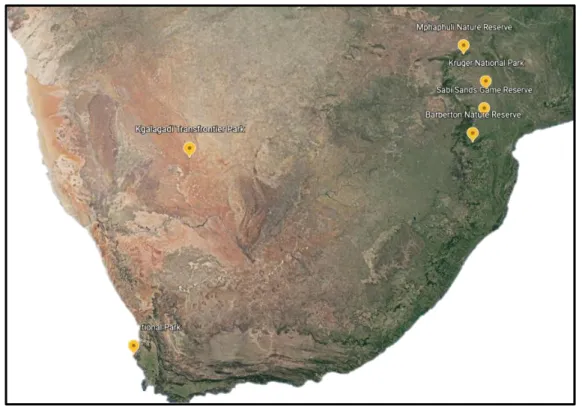
RESULTS AND DISCUSSION
- Introduction
- Case-by-case analysis and discussion
- Results related to Case study # 1
- Results related to Case Study # 2
- Results related to Case Study # 3
- Results related to Case Study # 4
- Results related to Case Study # 5
- Results related to Case Study # 6
- Cross-case analysis and discussion
- KPA 1: Waste-related information
- KPA 2: Implementation measures of the waste management hierarchy
- KPA 3: Pollution prevention measures
- KPA 4: Circular economy initiatives
- Conclusion
However, this is not surprising as zero waste to landfill and circular economy initiatives are directly based on the implementation of the waste management hierarchy (avoid, reduce, reuse, recycle waste, treatment and disposal). Finally, no initiatives were proposed to divert waste from landfills or to undertake circular economy initiatives because the waste management hierarchy was not initially implemented for the proposed development KPI 4.1=F and KPI 4.2=F. 4 of the National Waste Management Strategy (NWMS) requires training to be provided to stakeholders, staff or visitors.
The disposal of all waste generated was then recognized as the responsibility of the contractor KPI 2.5=F, indicating that the waste management hierarchy was not implemented. The second Key Performance Area (KPA) focuses on considering the waste management hierarchy as part of the waste management measures for the proposed development. Implementation of the waste management hierarchy is essential to prevent significant impacts on protected areas (Przydatek, 2019).
However, it should be noted that in two cases these waste management measures were not taken into account (KPI 3.1 B=2, C=2, F=2). The National Waste Management Strategy (NWMS) is a legislative requirement of national environmental management: Waste Act no.
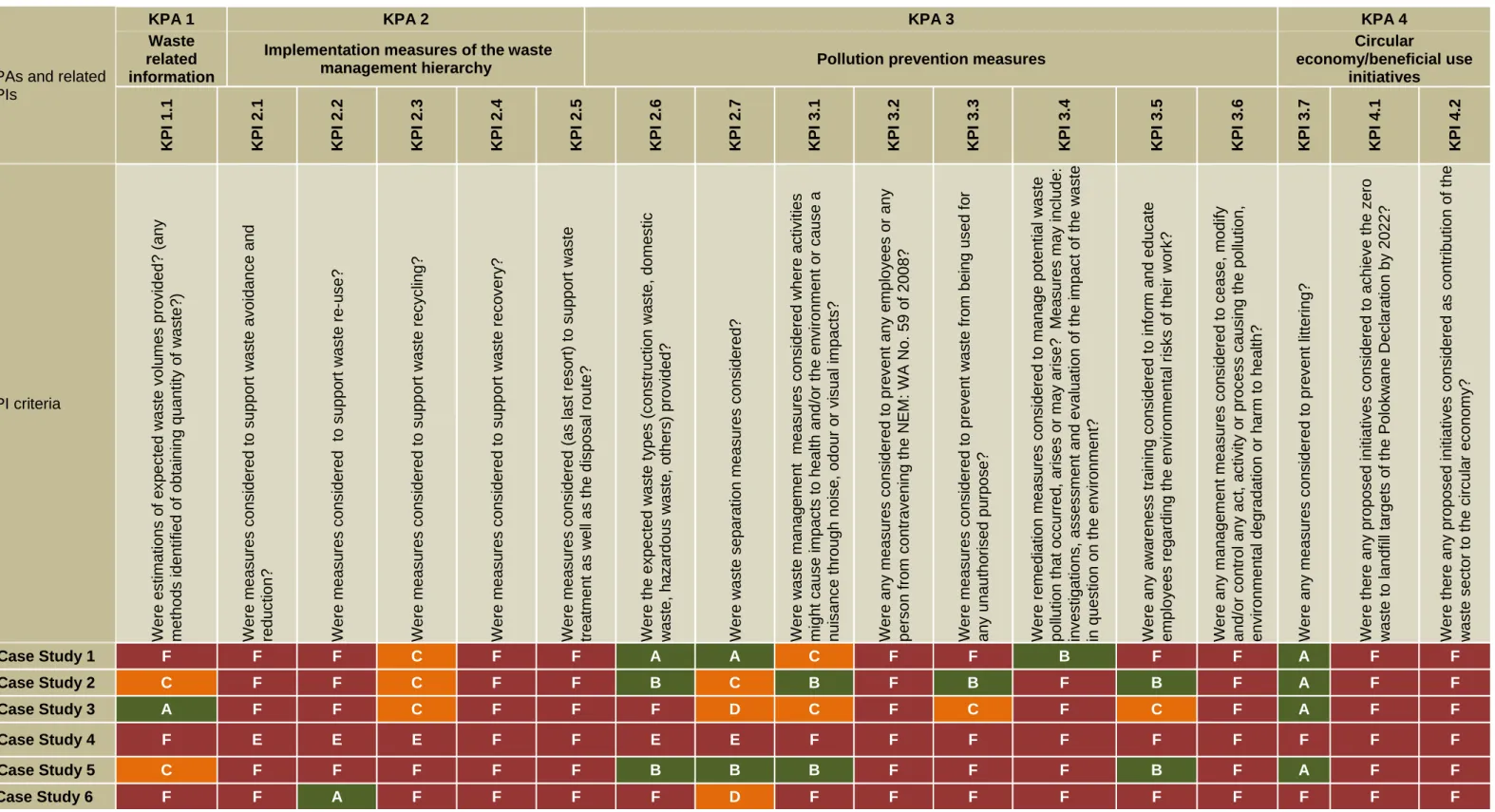
CONCLUSIONS AND RECOMMENDATIONS
Introduction
Conclusions
The EIAs generally did not take sufficient account of the implementation of the waste management hierarchy, as most of the EIAs did not reflect on the extent to which different components of the hierarchy could and should be implemented. Assume that the waste component of the EIA statement was correctly filled in with all necessary information to achieve the objectives of NEM: WA No. 59 of 2008. However, the waste component of the six EIA statements varied considerably, giving the impression that this information is not sufficiently considered by EIA decision-makers, as all EIAs were approved regardless of this deficiency.
This suggests that the waste component of EIA reports is not considered to be a decisive factor in the approval process and is something that should be addressed by the regulatory authority. If the expectation that waste measures should be properly considered and reflected in EIA reports is not communicated to officials and consultants, EIAs will continue to fall short in this regard. Currently, the standard Basic Assessment (BA) report template in relation to the Environmental Impact Assessment Regulations of 2014, issued under NEMA No.107 of 1998, does not require comprehensive waste information, which could be considered a gap by competent authority that was responsible for provide the necessary checklists.
Therefore, the environmental assessments have only provided the minimum information required by the competent authority. Therefore, it is concluded that the waste management component of the sample of EIA case studies did not provide effective information for the competent authority to make a well-informed decision.
Recommendations and areas of future research
South Africa is drowning in its own waste - are our regulators taking this crisis seriously. An assessment of the quality of the Environmental Impact Assessment Report relating to renewable energy projects in South Africa. Strategy and Structure: Chapters in the History of American Industrial Enterprise: MIT Press.
A critical evaluation of the environmental impact assessment system in South Africa based on case studies and literature review. Evaluation of the quality of environmental impact assessments using the Lee and Colley package in the Republic of Niger. Contribution of the Environmental Impact Assessment (EIA) to biological pest management decision making in South Africa – The case of Lantana camara.
Improving the quality of the environmental impact assessment report for solar photovoltaic projects in South Africa. Assessing the quality of EIA scoping reports related to hazardous waste management activities in South Africa.
